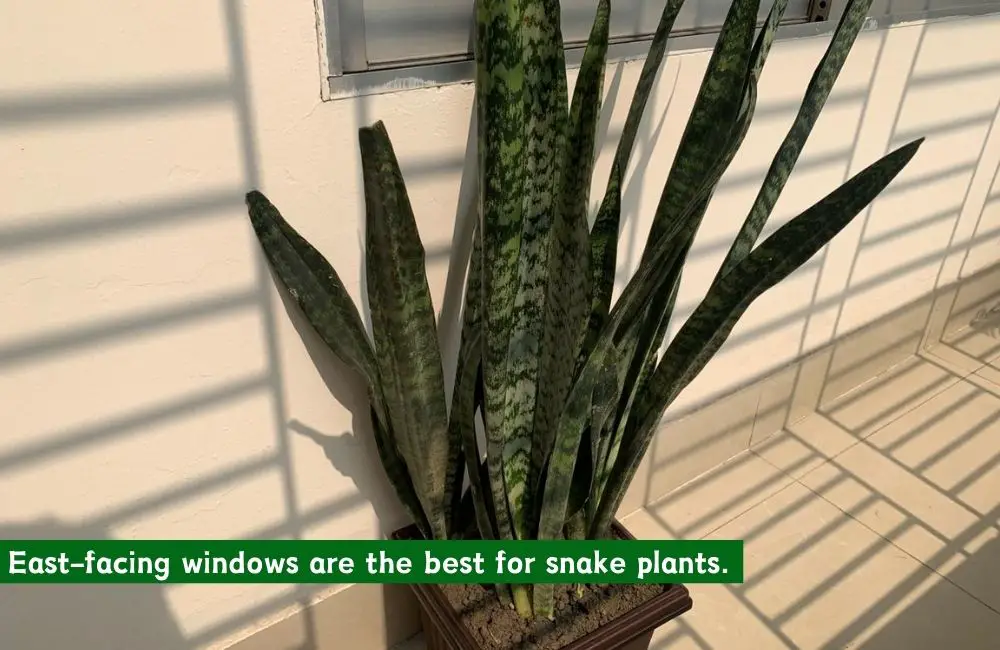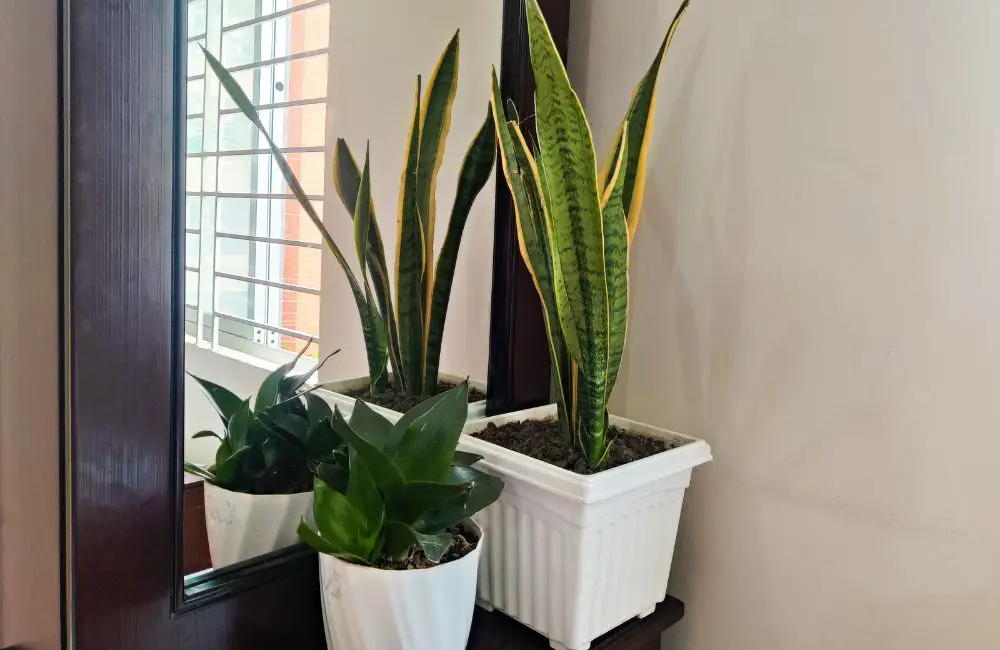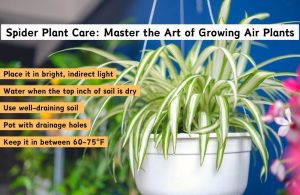This article covers the following areas –
- What Light Do Snake Plants Love?
- Can Snake Plants Handle Direct Sunlight?
- What Are the Perfect Spots for Snake Plants?
- When the Light is Low, What to Do?
- How to Handle Seasonal Changes?
- Practical Tips for Light Management
- Frequently Asked Questions
- Wrapping Up
I’m a big fan of the snake plant, known as Sansevieria or mother-in-law’s tongue. It’s not just its sleek, upright leaves that make it a favorite, but its hardiness and ability to thrive with minimal care. Today, I’m sharing everything I’ve learned about the ideal light conditions for snake plants to flourish in your home.
Snake plants thrive in various lighting conditions, from low to bright indirect light. They can tolerate direct sunlight but prefer indirect light to avoid leaf scorching. Optimal growth occurs in bright, indirect sunlight, making them versatile indoor plants.
For a deeper understanding of how light affects snake plants, including tips on placement and care for optimal growth and health, continue reading. This comprehensive guide will equip you with all you need to ensure your snake plant flourishes in your home environment.
What Light Do Snake Plants Love?

Snake plants enjoy being in bright, indirect sunlight. This kind of light mimics the natural conditions they love – bright but not directly under the harsh sun. It’s like they enjoy the sunlight while wearing a pair of sunglasses, getting all the benefits without any of the harm.
In their native environments, snake plants are used to growing under the cover of other plants and trees. This means they’re naturally adapted to flourish in conditions where the light is filtered through leaves, creating a dappled sunlight effect. Imagine sitting under a tree on a sunny day; that’s the ideal setting for these plants.
However, it’s important to note that snake plants are incredibly versatile. If your room doesn’t get a lot of natural sunlight, don’t worry. These plants can adjust to less light, making them perfect for spots other plants might not tolerate. They’re like the friend who’s happy to hang out in any room of your house, regardless of how much light it gets.
But, if they’re kept in very low light for too long, their growth can slow down, and they might not look as vibrant. Think of it as if they’re on a low battery; they can still function, but not at their best. It’s a gentle reminder that while they can handle various lighting conditions, giving them their preferred light when possible will help them thrive.
Lastly, if you’re lucky enough to have a space with a lot of indirect light, you’ll see your snake plant dancing. They might even surprise you by growing faster and possibly flowering, a rare treat. So, finding that sweet spot of bright, indirect light is like hitting the jackpot for you and your snake plant.
Can Snake Plants Handle Direct Sunlight?

Snake plants are quite resilient and can handle a bit of direct sunlight, especially during the cooler parts of the day. The gentle morning sunlight can be beneficial, giving them a boost of energy without causing any harm. It’s like enjoying a warm, sunny spot on a cool morning.
However, when the sun gets too intense, particularly in the afternoon, it can be too much for the snake plant. Like us getting a sunburn from being out too long in the strong sun, snake plants can get leaf burn. Their leaves might turn yellow or get brown tips as a sign they’re unhappy with the intense exposure.
Observing the plant’s response is key if you have your snake plant in a spot where it gets direct sunlight. If you notice any signs of distress, it’s time to move it to a place where the sunlight is more filtered or indirect. They’re telling you they’ve had enough sunbathing for the day.
Protecting your snake plants from the midday and afternoon sun is especially important for those who live in very hot and sunny climates. Placing them behind sheer curtains or slightly away from the window can help filter the light. It’s like giving them a pair of sunglasses and some shade to keep them comfortable.
So, while snake plants can enjoy a bit of direct sunlight, moderation is crucial. Too much direct sun, especially in the afternoon’s heat, can do more harm than good. Finding that perfect balance of light will keep your snake plant healthy and happy, allowing it to thrive in your care.
What Are the Perfect Spots for Snake Plants?

East-facing windows are the best for snake plants because they offer morning sunlight, which is gentle and less intense than the afternoon sun. This light is like a soft hug for your plant, giving it the warmth and brightness it needs without overwhelming it.
If you don’t have an east-facing window, placing your snake plant near a south or west-facing window works, too. Remember to keep it away from the window or use a sheer curtain to filter the light. This way, your plant gets enough light without the risk of sunburn. It’s like wearing a sunhat on a sunny day.
Another great tip is to notice how the light changes in your home throughout the year. During summer, when the sun is high in the sky, you might need to move your plant away from the window to protect it from the strong rays. It’s like moving into the shade when it gets too hot outside.
In winter, when the sunlight is less intense and days are shorter, you can move your snake plant closer to the window to catch as much light as possible. Think of it as basking in the winter sun, which feels good but isn’t too hot. This helps the plant stay healthy even during the darker months.
Remember, finding the perfect spot for your snake plant might take a bit of trial and error. Observe how your plant responds to its location and adjust as needed. It’s like finding the best spot at a picnic; once you find it, you’re all set for a good time.
When the Light is Low, What to Do?

If your home doesn’t get much natural light, you can still make a cozy spot for your snake plant. These plants don’t mind low-light conditions, making them ideal for less sunny spaces. It’s like they have a built-in low-power mode that helps them adapt and survive.
Even though snake plants can handle lower light, giving them a light boost is good when you can. Moving them to a brighter spot for a day or two occasionally lets them soak up some extra light. Think of it as taking them out for a little sunbath before bringing them back to their usual spot.
Artificial lighting is another great option for snake plants in dim areas. A simple fluorescent or LED grow light can provide the light your plant needs without being too harsh. It’s like having a little sun indoors that you can turn on and off as needed.
Remember, while snake plants are low-light champions, they still need some light to do their best. Keeping them in a spot that gets indirect light from a nearby window or artificial light can keep them happy and healthy. It’s all about finding the right balance, similar to adjusting the brightness on your phone screen for comfortable viewing.
Lastly, be patient with your snake plant in low light. Its growth might slow down, but it won’t stop. Over time, you’ll notice it quietly thriving, proving that it doesn’t need much to make a big impact. It’s a testament to the resilience and adaptability of these incredible plants.
How to Handle Seasonal Changes?

When summer rolls around, and your home is filled with sunlight, your snake plant will soak up all that extra light with joy. It’s their time to shine, as the longer days provide ample light to grow and maybe even produce a flower or two. They’re on a summer vacation, enjoying all the fun under the sun.
As autumn approaches and the days shorten, you might notice a slight slowdown in your snake plant’s growth. This is perfectly normal, as they’re adjusting to the changes in light, just like we adjust our wardrobes for the changing seasons. It’s their way of getting cozy for the cooler months.
Winter brings a different challenge with its shorter days and less intense sunlight. Your snake plant will enter a sort of semi-hibernation, slowing its growth but still holding strong. You can help by placing it in the brightest spot or using artificial lights to mimic the sun’s rays. It’s like giving your plant extra warmth and light to snuggle up to.
When spring comes and the natural light increases again, your snake plant will slowly wake up from its winter rest. This is a great time to give it a little more attention, perhaps with some water and a check-up, to prepare it for the growth spurt that comes with spring. It’s like stretching after a long nap, ready to grow and stretch towards the sun.
Your snake plant remains a loyal and resilient companion through all these seasonal changes. Its ability to adapt to varying light conditions throughout the year is remarkable, making it a perfect plant for beginners and experienced plant lovers. It’s a testament to the resilience and beauty of nature right in your living room.
Practical Tips for Light Management
Ensuring your snake plant gets just the right amount of light doesn’t have to be complicated. With a few simple strategies, you can create the perfect lighting environment for your plant to thrive. Here are practical tips to manage light effectively for your snake plant, making it easy for anyone to follow.
1. Rotate Your Plant Regularly

Rotating your snake plant regularly ensures it grows evenly and doesn’t lean towards the light. This is because all sides of the plant get their turn facing the light source, promoting balanced growth. It’s like ensuring every cake part gets evenly baked by turning it in the oven.
Doing this simple action once a week can prevent your plant from bending toward the light, leading to uneven growth. Think of it as exercising your plant, ensuring it grows strong and straight. This helps the plant look better and supports healthier growth overall.
If you forget to rotate your plant, you might notice it starting to lean or grow more on one side. This is the plant’s way of reaching for the light. By rotating it, you’re helping it stand tall and proud, avoiding awkward bends or leans.
This tip is especially useful during the darker months when your plant might be straining towards the light more. Keeping up with regular rotations can make a big difference in how your plant looks and feels. It’s a small step that can lead to big improvements in your plant’s health and appearance.
2. Use Artificial Lights as Needed

Artificial grow lights can be a game-changer for snake plants in low-light environments. They mimic the sun’s natural spectrum, giving your plant the energy to photosynthesize and grow. It’s like having a mini sun inside your home that you can turn on whenever needed.
Using artificial lights is particularly helpful during winter when natural sunlight is scarce. A few hours under these lights can significantly boost your plant’s health. Think of it as giving your plant daily sunshine, no matter the weather outside.
However, it’s important not to overdo it. Snake plants don’t require as much light as some other indoor plants. Setting up your artificial lights to turn on for a few hours daily is usually enough. It’s about finding that sweet spot where your plant gets just enough light without getting overwhelmed.
When setting up artificial lights, ensure they’re not too close to the plant to avoid overheating or burning the leaves. A safe distance ensures your plant gets the benefits of the light without any damage. Imagine it as sunbathing; too close, and you might get sunburned, but the right distance gives you a warm, glowing tan.
By incorporating these practical tips into your care routine, managing light for your snake plant becomes straightforward and stress-free. Whether making sure it gets evenly rotated or supplementing with artificial light, these steps can greatly enhance your plant’s growth and vitality, ensuring it remains a vibrant part of your home.
Frequently Asked Questions
If your snake plant is in too dark a spot, its growth may stall, and its vibrant green color might fade. It’s a sign to move it closer to a light source.
Absolutely! While natural light is best, snake plants can grow under artificial lights alone, making them ideal for offices or rooms without windows.
Snake plants require less water in low light conditions and slightly more in brighter environments. Always check the soil before watering; it should be dry a couple of inches deep. In brighter light, you might water every 2-3 weeks, while watering once a month in low light could suffice.
Yes, too much direct sunlight can lead to sunburned leaves characterized by brown spots or fading colors. While snake plants can handle some direct light, prolonged exposure to intense sunlight should be avoided to keep your plant healthy.
Generally, yes. Snake plants grow more vigorously in brighter, indirect light conditions. However, it’s important to balance this with proper care, as too much direct sunlight can cause damage. Indirect, bright light is the sweet spot for faster growth without the risk of harm.
Signs that your snake plant is getting too much light include faded, bleached leaves or crispy, brown edges. If you notice these symptoms, move your plant to a location with less direct sunlight.
While snake plants are low-maintenance and can thrive in low light without fertilizer, giving them a mild, balanced fertilizer during their growing season (spring and summer) can enhance their growth, even in low light. However, do so sparingly, as too much can harm the plant.
Look for LED or fluorescent grow lights that emit a broad spectrum of light. These types of lights mimic natural sunlight and can support healthy growth. Ensure the lights are not too close to prevent leaf burn, and use them for about 6-8 hours a day for the best results.
Yes, plants in brighter light may use water more quickly due to increased photosynthesis and evaporation, requiring more frequent watering. Conversely, snake plants in lower light use water more slowly and need watering less often. Always check the soil moisture level to guide your watering schedule.
Wrapping Up
Caring for a snake plant is a breeze when you understand its light requirements. They’re not just survivors but adaptable warriors of the plant world, thriving in various conditions, from the bright, indirect light to the dim corners of your home.
Whether you’re a seasoned plant parent or a newbie, the snake plant is a forgiving friend, asking for little but offering a lot in return. Keep these light tips in mind, and watch your snake plant flourish, adding a touch of green serenity to your space.






